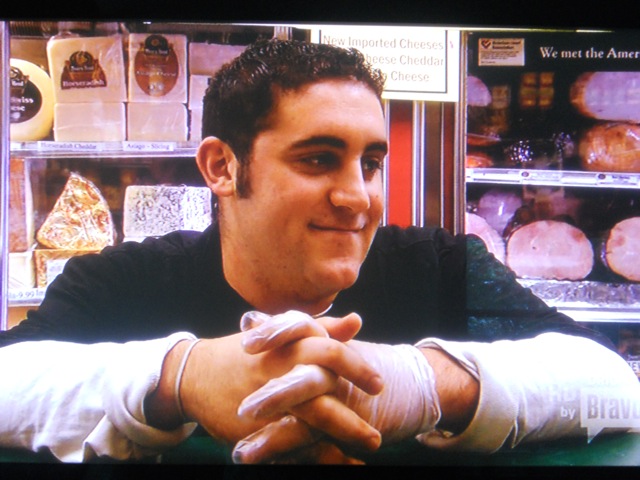I do not buy stuff from the deli-counter. I buy stuff that is pre-packaged and may contain antimicrobials, depending on what country you are in.
 It’s all about the slicers, whether it’s the little ones at the deli counter or the huge industrial ones in food facilities – I’m looking at you Maple Leaf, source of 23 dead in 2008 in Canada – and how hard they are to properly clean.
It’s all about the slicers, whether it’s the little ones at the deli counter or the huge industrial ones in food facilities – I’m looking at you Maple Leaf, source of 23 dead in 2008 in Canada – and how hard they are to properly clean.
Should deli meats be served in hospitals or aged care facilities where the immunocompromised abound?
The U.S. Centers for Disease Control reports a total of 8 people infected with the outbreak strain of Listeria monocytogenes have been reported from 4 states.
All 8 people have been hospitalized, and one death has been reported from Michigan.
Epidemiologic and laboratory evidence indicates that meats and cheeses sliced at deli counters might be contaminated with Listeria monocytogenes and could make people sick.
In interviews, ill people report eating different types and brands of products, including meats and cheeses, purchased from and sliced at deli counters in many different retail locations.
The outbreak strain has been identified in samples taken from meat sliced at a deli and from deli counters in multiple stores.
A single, common supplier of deli products has not been identified.
CDC is not advising that consumers avoid eating products prepared at delis, or that retailers stop selling deli-sliced products.
Retailers should clean and sanitize deli slicers.d
This outbreak is a reminder that people at higher risk for severe Listeria infection should handle deli-sliced meats and cheeses carefully to prevent illness. Pregnant women and their newborns, adults age 65 and older, and people with weakened immune systems are more likely to get sick with listeriosis.
People who are at higher risk for Listeria infection should avoid eating lunch meats, cold cuts, or other deli meats, unless they are heated to an internal temperature of 165°F or until steaming hot just before serving.
If you develop symptoms of a Listeria infection after eating deli-sliced products, contact a healthcare provider and tell them you ate deli-sliced products. This is especially important if you are pregnant, age 65 or older, or have a weakened immune system.
If you have eaten deli-sliced products and do not have any symptoms of a Listeria infection, most experts believe that tests or treatment are not needed, even for people who have a higher chance of Listeria infection.
Listeria bacteria can survive at very low temperatures and can spread easily to other foods and surfaces. Consumers should clean refrigerators, kitchen countertops, utensils, and other surfaces that touch deli-sliced products.
You can take steps to prevent Listeria infection:
Don’t let juice from lunch meat and hot dog packages get on other foods, utensils, and food preparation surfaces.
Wash hands after handling deli meats, lunch meats, deli cheeses, and hot dogs.
Store opened packages of meat sliced at a local deli no longer than 3 to 5 days in the refrigerator.



 Caroline’s family went to visit their daughter Lauren’s boyfriend’s family at their Italian food store, Little Italy Deli. One of the men behind the counter handed Caroline a bowl of soup with a gloved hand, and then Marco (or Vito Jr’s brother) struck this pose (right, exactly as pictured). What’s the point of wearing sanitary gloves if you’re going to rub them on your unprotected hand? Apparently there is some cultural confusion about whom the gloves protect, the food handler or the client. In food safety language this is referred to as magic glove syndrome.
Caroline’s family went to visit their daughter Lauren’s boyfriend’s family at their Italian food store, Little Italy Deli. One of the men behind the counter handed Caroline a bowl of soup with a gloved hand, and then Marco (or Vito Jr’s brother) struck this pose (right, exactly as pictured). What’s the point of wearing sanitary gloves if you’re going to rub them on your unprotected hand? Apparently there is some cultural confusion about whom the gloves protect, the food handler or the client. In food safety language this is referred to as magic glove syndrome. listeria contamination, according to a study by University of Arkansas researchers funded by the American Meat Institute Foundation.
listeria contamination, according to a study by University of Arkansas researchers funded by the American Meat Institute Foundation. “After careful study of the records, the physical plant and product test results received from the Canadian Food Inspection Agency (CFIA), internal and external experts have concluded that the most likely source was a possible collection point for bacteria located deep inside the mechanical operations of two slicing machines on lines 8 and 9. Rigorous sanitization of this equipment was completed on a daily basis in accordance with or exceeding the equipment manufacturer’s recommendations. However, upon full disassembly, areas were found where bacteria may accumulate deep inside the slicing machines and avoid the sanitization process. There were also other environmental factors, not on product contact surfaces, that may have contributed to the contamination.
“After careful study of the records, the physical plant and product test results received from the Canadian Food Inspection Agency (CFIA), internal and external experts have concluded that the most likely source was a possible collection point for bacteria located deep inside the mechanical operations of two slicing machines on lines 8 and 9. Rigorous sanitization of this equipment was completed on a daily basis in accordance with or exceeding the equipment manufacturer’s recommendations. However, upon full disassembly, areas were found where bacteria may accumulate deep inside the slicing machines and avoid the sanitization process. There were also other environmental factors, not on product contact surfaces, that may have contributed to the contamination.